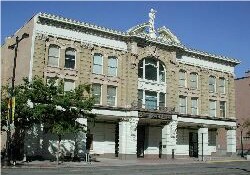
|
|
Promised Valley Playhouse (Orpheum Theatre, Utah Theatre, Wilkes Theatre, Casino Theatre, Wilkes Theatre, Playhouse, Roxy Theatre, Lake Theatre, Lyric Theater) 132 South State Street Salt Lake City, Utah (1905 - 1996) |
The Orpheum Theatre opened on Christmas Day 1905 as Salt Lake's first full-time vaudeville house.
The 900-seat theater, an excellent example of "Second Renaissance Revival", was designed by architect C.N. Neuhausen. A 12-foot statue of Venus tops its central section, while larger-than-life heads guard the front entry. The auditorium and main lobby have been refurbished several times. Except for the stage, little remains of the original building. An old unused hotel behind the auditorium used to house vaudeville performers.
In 1918, the theater was converted to show movies and was known by several names including the Casino, Orpheum, Wilkes, Roxey, Salt Lake, and Lyric. The Lyric had one of the first crying rooms in town, and even employed a registered nurse in its ladies room. In 1953 it was one of the first two theaters in Salt Lake to show widescreen movies with stereo sound.
Cinemascope
On 1 October 1953, the Lyric and the Villa became the first theaters in the Salt Lake area to show widescreen movies with stereo sound. Both theaters showed The Robe, the first movie filmed in a new process called CinemaScope.[1]
After the debut of Cinerama in 1952, studio executives raced to develop a similar widescreen process. 20th Century Fox acquired world rights to Anamorphoscope, a filming process developed by Prof. Henri Chrétien, and renamed it CinemaScope.
CinemaScope used an anamorphic lens to squeeze a wide image onto traditional 35mm film during filming. Movie theaters were equipped with large wide screens, with a slight curve, and then the image was stretched back out using another lens. The result was an image twice as wide as traditional movies, without the extra complication and expense of using three separate cameras and projectors as with Cinerama.
CinemaScope also provided stereo sound using four magnetic tracks on either sides of the sprocket holes. Three channels of sound were behind the screen and the fourth used speakers on the side and rear walls of the auditorium. Although movie studios expected this stereo sound format to become the standard, movie theaters operators resisted the high expense and an optical mono soundtrack was later added to CinemaScope prints.
Although the term CinemaScope is not longer used, many widescreen films today use the anamophic process.
Promised Valley Playhouse
In 1972, The Church of Jesus Christ of Latter-Day Saints bought and restored the building for church plays, renaming it the Promised Valley Playhouse. In 1996 the theater closed because of structural problems. In 2000, the Church replaced the playhouse by building a new 911-seat theater as part of its new Conference Center.
Salt Lake County paid $50,000 for an architectural study, but voted on 17 July 2001 against purchasing or leasing the theater because the high cost of restoring it. The study concluded that it would cost from $2 million for a basic seismic upgrade to $30 million for a full restoration.
Demolition of the auditorium began in September 2002, but the facade, lobby, and office area was saved. On 9 January 2004, LDS Family Services began moving its office into the first three floors of the renovated Promised Valley Playhouse. The agency was previously located in the 12th floor of the Zions Bank Tower, which is being renovated.
1. "'The Robe' in CinemaScope Declared Film Spectacle", Deseret News, 1 October 1953
